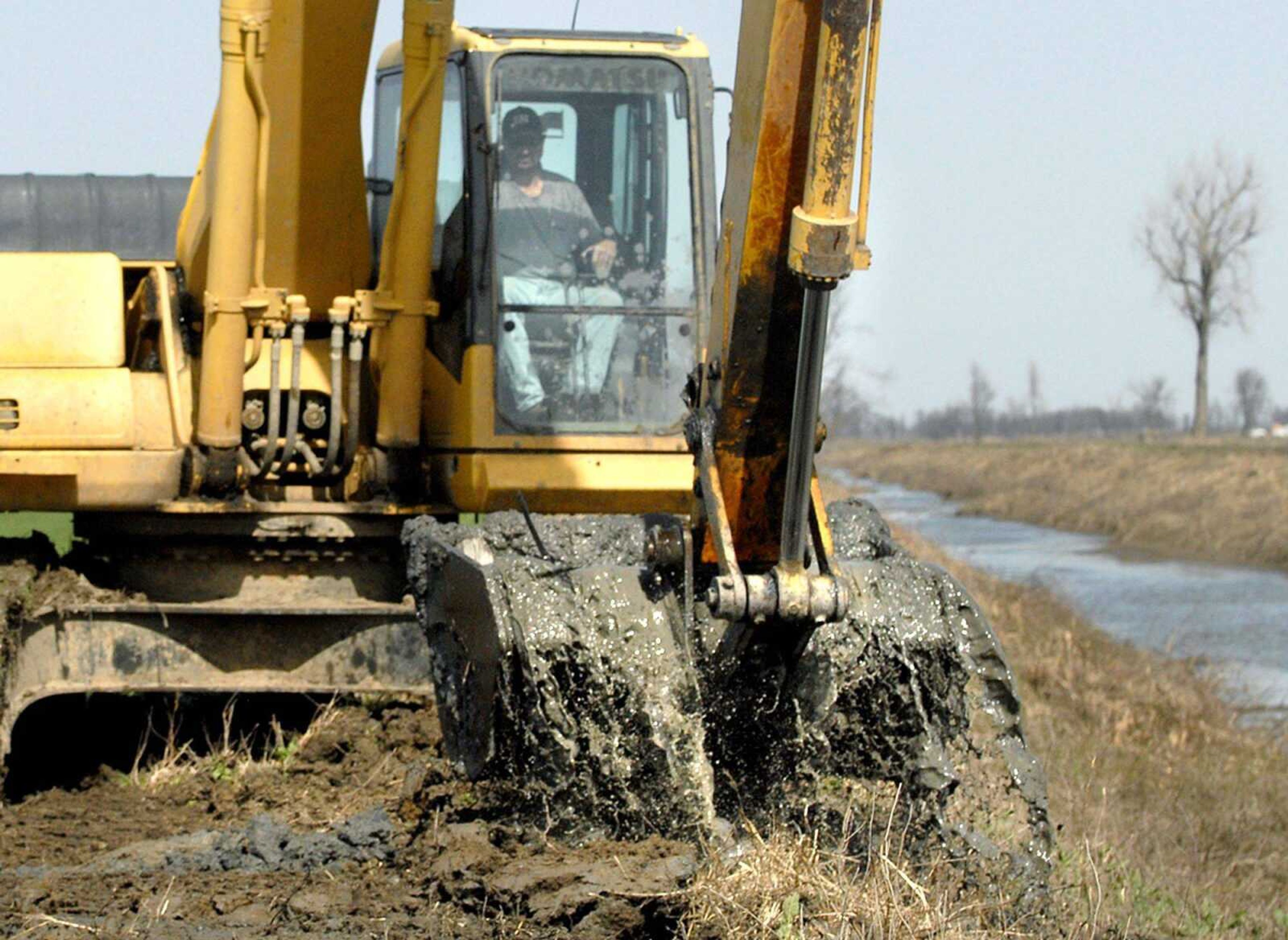Floodway ditches being dug out; farmers worry work may be too late
It's crunch time. With bright green wheat sprouts already blanketing much of the Birds Point-New Madrid Floodway, excavators sit on the banks of silted-in ditches. One scoop at a time they're digging out what the U.S. Army Corps of Engineers' breach of the Birds Point levee left behind in May...
It's crunch time.
With bright green wheat sprouts already blanketing much of the Birds Point-New Madrid Floodway, excavators sit on the banks of silted-in ditches.
One scoop at a time they're digging out what the U.S. Army Corps of Engineers' breach of the Birds Point levee left behind in May.
Although they're glad to see the work underway thanks to the U.S. Department of Agriculture's Emergency Watershed Protection Program, floodway farmers worry the help may be too late.
A rising river and heavy spring rains could easily overwhelm the current capacity of the ditches -- flooding fields where wheat is already growing and corn will soon be planted.
"It's not being done as quickly as it should have been," said Eddie Marshall, a fourth-generation Mississippi County farmer. "We could have big rains and a big river, and in two weeks time we could be where we were last year."
The Natural Resources Conservation Service, a branch of the USDA, administers the Emergency Watershed Protection Program. It's providing $35 million to repair ditches throughout Southeast Missouri damaged in last spring's flooding.
Since the funding was released in January, the NRCS has quickly completed engineering plans for an estimated 60 projects, said Mark Nussbaum, an engineer with the NRCS in Jackson. The NRCS has partnered with 24 "sponsors," typically either drainage districts or county commissions, to administer the projects.
"We have success when we can get the technical and financial assistance to the sponsor. It's their goal to do this quickly and to do it right," Nussbaum said.
The NRCS's initial focus is on $9.2 million worth of ditch restoration in the Birds Point-New Madrid Floodway, Nussbaum said.
Last May, as the Mississippi River washed over 130,000 acres of farmland, it filled 140 miles of the area's network of drainage ditches with up to eight feet of dirt, sand and debris.

"The only way people can live in the Bootheel is because of quality drainage," Nussbaum said. "The drainage has to be there before anything else."
Mississippi County Consolidated Drainage District No. 1's Ditch 29, off County Road 314 in Mississippi County, is the first to be cleaned out. Work has been underway for about two weeks as excavators line both sides of the ditch scraping out sediment. Once it's dry, the material will be tilled into nearby fields.
"We aim to have all projects under construction by late April. Weather permitting, our sponsors should complete restoration work this year," Nussbaum said.
By mid-May, he estimates, about 130 pieces of heavy equipment will be operating throughout the Bootheel, creating about 300 jobs.
$4M for farm damage
Along with funds to repair the floodway's drainage system, the USDA provided $4 million through its Emergency Conservation Program administered by USDA's Farm Service Agency. That funding helped farmers repair their drainage ditches and restore farmland by removing sand and debris or fill gullies left behind after last spring's flooding.
While that money is appreciated, Marshall said the funds he received are a "drop in the bucket" compared to what it cost him to repair the damage caused by the levee breach.
He estimates he has spent $250,000 on repairs and has received $16,000 in reimbursements from the USDA.
"We're not asking for a handout. I don't want anything I didn't have before," he said. "I just want to be paid for my ditches and my land."
Of the 8,000 acres he farms in the spillway, last year he was unable to plant about 1,200 acres. This year, he still has 200 acres that can't be planted and says it will take hundreds of thousands of dollars to get those acres back into shape.
$46M for lost crops
About 32 percent of the wheat planted last year in Mississippi County wasn't harvested; instead, flooding turned what could have been a successful crop into a matted, muddy mess.
"That crop is gone," Marshall said.
The USDA's Risk Management Agency, which operates the Federal Crop Insurance Corp., paid $46.6 million in indemnities to farmers in New Madrid, Mississippi, Scott, Stoddard, Pemiscot and Dunklin counties in 2011. Crop insurance payments totaled $377 million statewide and topped $10 billion nationally last year.
"This is a record by far," said Bill Murphy, administrator of the Risk Management Agency. "I've been with the program for 30 years, and I don't remember a year like this before."
In Mississippi County, indemnity payments to farmers totaled $14.4 million. More than half of that was paid on lost corn crops. In New Madrid County, $6.1 million in indemnity payments were made -- mostly for corn losses but also for a large amount of rice.
The USDA's Noninsured Disaster Assistance Program provides funding to help cover crop losses when federal crop insurance is not available. A total of $87,877 was paid to Mississippi County farmers as a result of flooding that prevented rice crops from being planted.
After farmers faced crop insurance premiums double or triple normal rates, the USDA's Risk Management Agency recently confirmed the temporary levee built at Birds Point by the Corps of Engineers is considered adequate protection. New Madrid and Mississippi County farmers' crops in the floodway will no longer be deemed high-risk, saving them about $70 per acre, Murphy said.

Work on rebuilding the levee to its original height, which offered protection at a river stage of 62.5 feet, stopped in December because of the weather. The temporary levee offers protection from flooding at a river stage of 55 feet.
"Right now, we don't have a lot of snow pack up north, so that's good," Marshall said.
Still, he's nervous about the upcoming growing season.
"That's just part of being a farmer," he said.
mmiller@semissourian.com
388-3646
Pertinent address:
Mississippi County, MO
Connect with the Southeast Missourian Newsroom:
For corrections to this story or other insights for the editor, click here. To submit a letter to the editor, click here. To learn about the Southeast Missourian’s AI Policy, click here.











